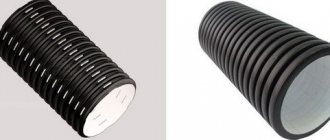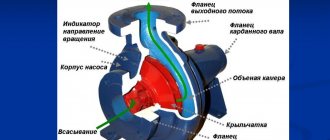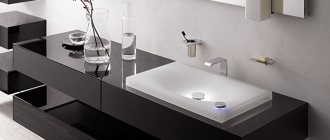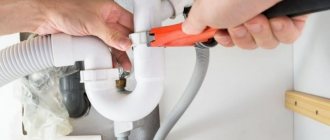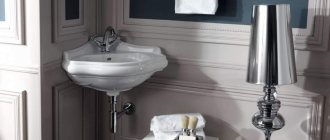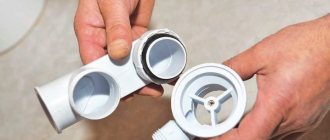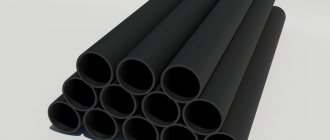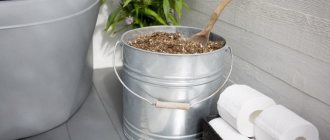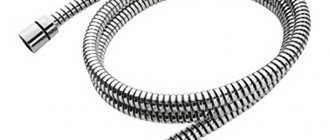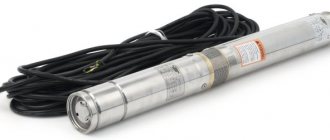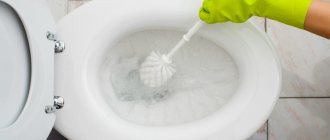A water seal (siphon) is an essential element of any modern sewer system. The device is a system of pipes of a special shape that helps isolate sewage washed into sewer pipes from the room environment. Between the cavity of the drain pipe and its end that goes into the plumbing fixture - toilet, sink or bathtub - there is always a certain amount of water. Thanks to this, volatile substances from the wastewater do not enter the indoor air. Nowadays, not a single plumbing fixture can be installed without installing a water seal.
It is obvious that the convenience, efficiency and durability of using installed sinks, bathtubs, and toilets directly depends on the quality of the siphons installed with them. Therefore, in our article we will consider the types of these devices, the features of their operation and the principles of selection.
What is a siphon used for?
In fact, these are just hydraulic valves (or gates) in the form of a special hydraulic device that regulates the flow of liquids (including water) by changing the position of the control and shut-off element. Such hydraulic valves perform several “responsibilities”; they must: • maintain clean air and prevent sewer odors from entering the premises; • make it clear to your owner that he is letting something wrong go down the drain; • preventing clogging of the sewer pipe itself (this is one of the best qualities of siphons).
How does a water seal work?
Regardless of where exactly the hydraulic valve is installed, it must not only prevent unpleasant odors from entering the apartment, but also protect the pipes from serious water hammer during flushing.
There are several different types of siphon designs for sewerage, and all of them are sets of pipes of a certain shape, which are sometimes supplemented with auxiliary elements. With regular use of plumbing fixtures, the water column in the siphon is constantly updated, which guarantees the absence of odors.
Design
Hydraulic valves are divided into two types - double-turn (water layer height 7 cm) and bottle valves (water layer height 6-7 cm). The materials for the production of siphons are varied - these include cast iron and plastic (polyethylene or propylene is used; such siphons do not corrode, cannot rot or rust), as well as brass, nickel, ceramics, rubber, copper (such a siphon will not rust, but will oxidize , as a result of which all the dirt, which is difficult to remove, will begin to stick to it).
When choosing a “water trap”, it is necessary to evaluate not only financial possibilities, but also the area where the plumbing fixtures will be installed (and, accordingly, the siphon).
Don’t forget about the quality and practicality of the product you choose, and you should also take into account the design.
It must be said right away that double-turn siphons are difficult both to install (fastening is done using a metal or plastic nut, so not only precise action is required, but also strength) and to operate (it will not be possible to unscrew it by hand when trying to clean it, because first you need to unscrew this very nut), plus these siphons consist of many parts, and in the absence of skill, such a siphon will be a complex puzzle. But regarding practicality, the best siphons are those made of cast iron. All the debris in such a siphon accumulates in one place - the bend (or, as it is also called, “revision”) and from there it is cleaned out quite easily.
It will be easier to install and use in practice a bottle version of the siphon, which is installed with all plumbing fixtures except the toilet (here the role of the siphon is performed by bending the sewer drain located at the base of the toilet). For its production, manufacturers give preference to nickel, brass and plastic (color white and black).
What types of siphons are there for arranging floor drains?
The most popular type of shower siphon, the tray of which is made flush with the floor, is a plumbing drain. The material from which the drain is made is polypropylene, the advantages of siphons of this type are as follows: it does not rust, corrode, rot, takes up little space, and is easy to install. The height of the ladders varies from 80 to 200 mm.
Laying a shower siphon on the floor
For installation, it is necessary to either remove the floor and install a siphon between the joists, or groove if the floor is concrete. Drains are now installed not only in bathrooms. Their installation in the garage allows you to wash off dirt from the car without using a car wash and without dirtying the floor; the ladders on the balcony allow sediment to drain, falling and flowing into the frame. If you constantly forget to turn off the water in the bathroom or kitchen, a drain installed there will help protect your neighbors from floods and flooding. This type of drain also makes cleaning easier - pour some water, point it with a rag towards the drain and there is no need to collect or squeeze anything out.
There are other types of floor shower siphons, namely:
- corrugated siphon.
Due to its flexibility and small diameter, it is used in the narrowest and lowest places. Installation is simple - you bend the corrugation in the right place at the right angle and simply attach it to the wall with special fasteners. The disadvantages of corrugated siphons are their folds. Hair, animal fur, dirt, and pieces of soap often get stuck in them. It is very difficult to clear clogged drains located in the floor due to the lack of direct access; Plumbing siphon - The bottle siphon is most often used in the kitchen under the sink. It got its name because of its shape, somewhat reminiscent of a bottle. It is in this part that the waste from the drain settles. A positive factor for siphons of this type is easy cleaning - in order to remove debris, you just need to unscrew the bottom part. You will appreciate this advantage if you accidentally wash away something valuable, such as a ring or earring. It will be as easy as shelling pears to return what is lost. The disadvantages include bulkiness, which is not at all beneficial when installing a drain in the floor. If you live on the ground floor or in a private house, and there is some kind of technical room under the bathroom, then there is no question - install any type of siphons. But if your neighbors live on the floor below you, then you need to consider other options;
- The pipe siphon also takes up a considerable area, but it is much stronger than its corrugated counterpart. It is made of metal or plastic, and it looks like a U-shaped or S-shaped pipe. Cleaning is carried out by inserting a special cable into the pipe, which is also quite troublesome and labor-intensive, especially if the blockage is severe. Chemicals for clearing blockages can help, which in this case will save time, effort and money and will not harm the structure.
In addition to everyday, classic, so to speak, standard, there are also modern varieties of siphons. These include siphons with an automatic control system and siphons with a click-clack function.
What to look for when purchasing
When buying a plastic siphon (which is now popular), you need to pay attention to the fact that it has rubber seals and gaskets, which, according to the rules, are sold as a set.
Bathroom siphons are also called pipe siphons because they look like a curved tube. In fact, this type of hydraulic valve consists of two pipes - separately for draining and overflowing water. This type of siphon is designed for a spacious bathroom, where the mixer is installed solely to regulate the temperature, and the water flow itself comes from the overflow pipe.
There is another type of sewer siphon, which has an additional outlet. It was designed for ease of use in washing machines and dishwashers. The placement location is mainly under the sink, where a box specially designed for such a siphon is placed. The dimensions are small, so the box will not take up much space.
When installing all of the listed types of hydraulic valves, you need to know that they are all installed between the plumbing fixture and the drain. Installation methods depend solely on the manufacturer. Therefore, it is recommended to consult either the seller of siphons (some types come with instructions) or contact a specialist.
Additional functions
In some cases additional functions are required:
The overflow siphon is connected not only to the sink drain, but also to the overflow. If water almost fills the sink, it is removed through the overflow hole, bypassing the siphon. The overflow serves as protection against flooding of the room due to overflowing of the sink or bathtub. For the washing machine, a device is installed with an additional outlet through which the drain is performed.
There are also semi-automatic and automatic devices. The first ones have a mechanism installed that allows you to control the drain and block it if necessary. A button or a handle can be used for control. Automatic ones are equipped with a microprocessor that opens and closes the drain depending on whether the siphon is used.
Siphon maintenance
There are several methods for cleaning a hydraulic valve: - using liquid special agents. Usually everything is written in the instructions, but you can repeat it. For example, about 300 grams of solution is poured into the sink. Waiting time – 20 minutes. This is followed by rinsing with hot water for half an hour. If necessary, the procedure should be repeated several times until complete cleaning; - cleaning using home remedies. As a cleaning agent, you can use a saturated solution of washing soda (or caustic soda). About one and a half liters of this mixture should be poured into the siphon, but for no more than 14 minutes, so that the pipes do not corrode or are “corroded.” After this time, carefully, in a thin stream, so as not to lead to a sharp temperature change (the pipes may crack), it is necessary to pour boiling water; - promotion. In this case, you will need to unwind the connection. In order not to spoil the mood completely, you will need to place a wide basin under the sink (or something else), into which everything that is in the way will pour out. The disconnected siphon will need to be cleaned of dirt and then rinsed thoroughly. After these procedures, of course, put it back. In general, it is recommended to clean sewer siphons once every 3-4 months.
Recommendations for selection and installation
To purchase a suitable model, pay attention to several main points.
- The water seal must have a certain nominal diameter to ensure sufficient throughput, depending on the volume of wastewater. For a washbasin, a diameter of 50 mm is sufficient, for a bath or shower - at least 100 mm.
- If two washbasins are located on opposite sides of the wall, each of them is provided with a separate device.
- For a dishwasher or washing machine, select a product with the possibility of side mounting.
- To avoid blockages, it is better to equip a kitchen sink with greasy drains with a bottle-type water siphon.
- Drain with dry siphon for shower. It should be noted that horizontal models do not require a large headroom, since their own does not exceed 10 cm. For vertical varieties, a gap of at least 15 cm should be left.
- The shower drain is chosen according to its design: a protective grille made of plastic or stainless steel with shaped holes can play the role of a decorative element.
Finally, to ensure the functionality of the siphon, a small amount of water is poured through it.
The following recommendations will help you avoid mistakes when assembling plumbing fixtures yourself.
- The purchased device is checked for the presence of gaskets and the quality of their installation - without distortions, with a sufficiently tight fit.
- A special ring-shaped rubber gasket is placed between the sink and the dry seal so that there are no leaks at the junction.
- Install a siphon and treat the connections with silicone sealant.
Features of using a double-turn siphon
Such a siphon is also called differently: cranked, pipe or the same type. In colloquial speech it is simply called the knee.
Its design is quite simple and consists of a curved pipe, in the bend of which a water seal is formed.
Siphons of this type are installed mainly under sinks and washbasins.
Its main advantage is the high reliability of the device. The disadvantages of this system include:
- high cost, relative to other types of siphons;
- Cleaning the cranked siphon turns out to be an inconvenient and time-consuming process.
To make it possible to clean the water seal, a double-turn inspection siphon was developed, which has a special hole at the bottom or a removable elbow.
Corrugated siphon as an option of the cranked type.
To install drainage in a hard-to-reach place, it is convenient to use a siphon, which is a corrugated tube bent into the required shape and fixed in the desired position using plastic fasteners.
It will be interesting: Comparative review of electric and gas water heaters
Its advantage over others is the ability to install it in the desired position, regardless of the location of the rest of the plumbing.
The disadvantages of this device include its poor heat resistance. That is, by pouring hot water into it, you risk damaging the drainage system under the sink. Such a siphon may also not withstand low temperatures of water or ambient air.
In addition, dirt quickly accumulates on the ribs of the pipe, which clogs the siphon. And cleaning corrugated drainage is a very inconvenient and time-consuming procedure.
When choosing plumbing fixtures, it is best to think through the entire structure down to the smallest detail in advance, consulting with a specialist. A siphon made of high-quality materials and correctly installed can last a long time without requiring special attention. It will be able to conscientiously perform its sanitary and hygienic functions, ridding your home of unpleasant and harmful gases.
Currently reading
- Let us tell you in a nutshell why we need sink siphons
- Which siphons are best to choose for the kitchen or bathroom?
- How to choose the right siphons for dishwashers
- What are there and how to install siphons for mixers
